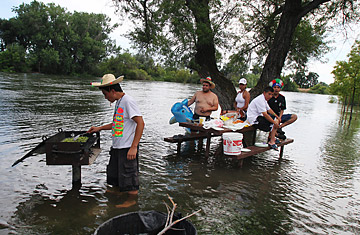
Jose Ramirez tends to the barbeque as his friends relax at Laton-Kingston Regional Park in Laton, California on June 18, 2011. The Kings River, like many in the state, is experiencing high flows due to releases from reservoirs necessary because of the melting snow pack in the Sierra Nevada.
When Marcia Rasmussen set out for a spring run on the trails of Sequoia National Park last week, it felt like just another season of backcountry training. But it hadn't been just another winter. All of a sudden, the snow underneath her trail collapsed and she fell into an icy creek that swept her downstream. Trapped in a snow tunnel for three hours, she almost died of hypothermia before she was rescued. "It's a very different situation up there than it has been in previous years," Rasmussen, 51, said as she recovered from her frostbite. "The snow is very, very heavy and melting very late this year."
The same snowmelt that put Rasmussen's life in danger upstream is putting dam operators on edge downstream. Officials are continuously monitoring rising reservoirs and strategically releasing water from dams to prevent overflowing and flooding in the cities and farmland below the mountains.
So far, California has escaped major flooding. Other parts of the country aren't as lucky. Record snowfall runoff from the Rocky Mountains and heavy rain this spring has swelled the Missouri River and threatened parts of Montana, Nebraska, Iowa, Missouri and the Dakotas. Thousands of residents of Minot, North Dakota are evacuating their homes as the Souris River is expected to exceed emergency levees. Residents of Craig, Missouri are also under orders to evacuate after levees were breached. And all this after the Mississippi River displaced thousands of people last month, also flooding crops, catfish farms and timberland.
"In the Rockies they've had a larger snowpack. They've had one of the largest snowpacks they've ever seen," says Mary Mullusky, chief of the hydrologic services branch at the National Weather Service. Now, snow runoff is complicated by heavy rainfall. "We're in this repetitive cycle where we're basically getting over some areas of the Missouri an inch to an inch and a half of rain every two to three days, so the soils aren't draining and the rivers aren't getting lower," Mullusky says.
In California, snow depths this winter were the fifth highest in the past 60 years. A cool spring kept much of the snow from melting, putting the snow's average water content at twice its historical average in some areas of Sequoia. That's making for a potentially dangerous snowmelt now that temperatures have spiked to over 100 degrees at the park entrance this week. Yosemite National Park is in a similar situation, with its Merced River expected to exceed flood stage this week. Parts of the Walker River in eastern California and Nevada have a flood warning and areas of the Humboldt River are above flood stage, according to the National Weather Service. "Our concerns over the next two weeks are that the reservoirs are filling," said Jon Ericson, chief of hydrology at the California Department of Water Resources. "It's really an issue of how fast the water comes off the mountains."
On the first day of summer in Sequoia's Mineral King area, campgrounds were still scattered with snow after officials were forced to open them later than usual this year. Creeks bursting with snowmelt crashed loudly down the sides of valleys, creating dramatic waterfalls and flooding hiking trails. Some visitors brought snowboards in an attempt to salvage the last traces of winter. Others ended their hikes early, unable to cross the bulging runoff. Park officials are trying to educate visitors about the dangers of the swollen streams to avoid casualties. Conditions are so unusual this year that Rasmussen's experience as a backcountry marathon runner and as a search and rescue worker wasn't even enough to help her navigate the terrain. "The risk of drowning is extraordinary," says Sylvia Haultain, a plant ecologist at the park.
That may have already happened downstream in California's Central Valley. Two campers from the Los Angeles area were reported missing last week after being swept down the Kern River above class five rapids. Numerous other search and rescue operations have been reported on the area's rivers. Authorities in several counties have closed recreational access to the Kings River because of its fast and dangerous current, which Tulare County parks manager Neil Pilegard calls "a great concern for public safety."
And as officials race to prevent flooding downstream, there is only so much they can do. "A lot of it is in mother nature's hands in terms of the temperatures," Ericson said. "An extended, prolonged hot period would mean that water would come at a very quick pace and that would be more difficult to manage."
